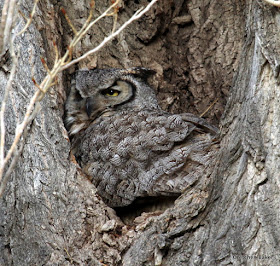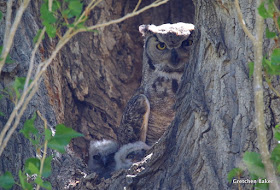
Are you ready for some owl photos? I hope so, because I have more than a few to share!
Two years ago, we were delighted when we found a nesting Great Horned Owl in our backyard silver poplar tree. We watched as the chicks progressed and eventually left. Last year we watched the trees in hope of a repeat show, but the owls did not choose that tree. Then this year, on April 8, I noticed an owl in the tree. I kept checking on her, finding her sitting different ways.
With our stay-at-home orders, I was in awe of this mom who could really stay at home...
Rain...

..or shine.
Sometimes she just looked so tired.
I could tell one day that she was doing something in her nest, and my guess was feeding young, but I couldn't see them. Finally, on April 25, I saw a little bit of white down. A chick had hatched! I was so excited!
I started observing more. The owls are about 25 feet up in the tree, and I can get the best views up into the tree crotch from about 80 to 90 feet away, so I use binoculars or my 400mm lens on my crop sensor camera. For these photos, after I downloaded them I cropped them to make the owls bigger. So you are looking at lots of magnification, much better than you can see with your naked eye.
Here's another little peek at white fluffiness.
Then mama owl got down low to her young.
Those eyes!

I wish I knew what she was doing here.
And then she gave me a peeved look.
Later came a more coquettish look.

And then just a sleepy look.
Showing off her tail feathers. Mama owl, I really want to see your babies!

Mama owl was not in any hurry to show me her babies. But she did give me lots of other looks.
And then, finally, today on 30 April 2020, I saw two young! I did such a happy dance.
 More photos to come...
More photos to come...

















































